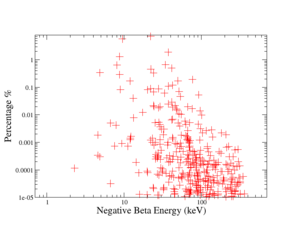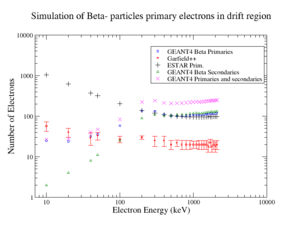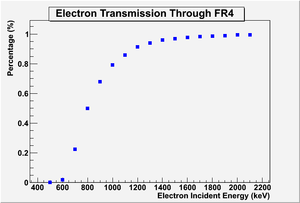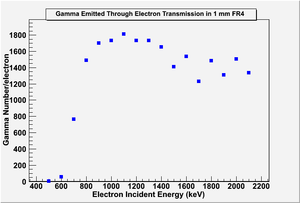Beta Transmission and Ionization
GEANt4 simulated beta particles in the drift region with a 90/10 Ar/CO2 gas. U-233 emits beta particles with a range extends up to 600 keV, they are low in rate compared to alpha rate, however, they share in the detector total charge. GEANT4 was used for simulating the charge for a beta particle that passed through the drift region, and estimated the primary and secondary electrons for each beta particle energy. Also GEANT4 helped in studying the penetration of beta particles through 1mm FR4 shutter.
Beta particles energy rates
Beta particles are emitted from U-233 radioactive isotope, their energy spectrum vs the percentage of the emitted bata is shown in figure XX, according to the figure the rates are lower than 0.1 percent, but it reaches to up to 6 percent for beta energies of 10 keV and 30 keV.
Primary and secondary ionization
A simulation for beta ionization is performed using GEANT4. GEANT4 simulated the interaction of a beta particle in the drift region that contained 90/10 Ar/CO2 gas; the simulation estimated the ionization primary and secondary electrons, figure XX and yy show the results.
The primary and secondary ionization graph shows that the number of primary and secondary electrons decreased when the incident beta particle increased, which agrees with Bethe-Bloch equation for estimating the energy loss.It also shows that beta with energy of 400 keV and above contribute with least number of free electrons in the drift region, the number of electrons are 10-17 electrons by end of the drift region,
Betas' Ionization with the FR4 shutter
The FR4 shutter decreases the rate of emitted beta from U-233. the following figure shows the beta particle transmission through a 1 mm of FR4:
80% of Beta particles of 1 MeV penetrate the shutter, and it is close to 100% penetration as beta's energy is above or equal 1.3 MeV. So the shutter stops all beta particles that are lower 400 keV, as mentioned previously, those low energy beta has the major contribution to the total number of free electrons in the drift region.
Electron multiple scattering causes Gamma particles to appear through beta transmission in the FR4. Electron scattering is one of the interactions of beta particles with FR4, photons are produced through this process depending on beta's energy.
It is noticed from the figure above that the maximum scattering cross section is for 1100 keV beta particles, the number of photons reaches to 1800 for each beta particle that transport through 1cm of FR4.



